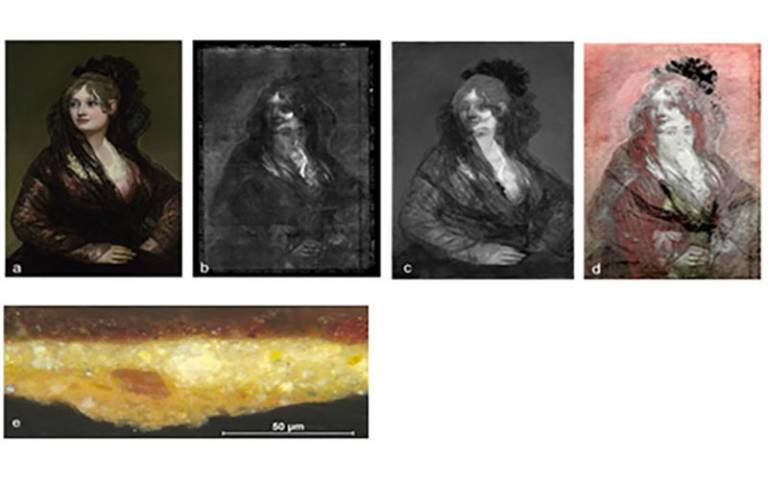New research collaboration with the National Gallery
3 July 2018
The EPSRC has funded a major research grant, allowing researchers in the Department of Electronic and Electrical Engineering to collaborate with the National Gallery.

Congratulations to Dr Miguel Rodrigues, Reader of Information Theory and Information Processing in the Department of Electronic and Electrical Engineering, who has recently had a major research project funded by the Engineering and Physical Sciences Research Council (EPSRC). The project, titled 'ARTICT: Art Through the ICT Lens: Big Data Processing Tools to Support the Technical Study, Preservation and Conservation of Old Master Paintings' (EP/R032285/1), aims to bring digital signal processing technology to the arts. The project is in partnership with the National Gallery and was funded through the recent 'Co-Creation and Cross-Disciplinary in ICT Research' call.
The heritage science sector is experiencing a digital revolution linked to the emergence and increasing adoption of cutting-edge non-invasive analytical imaging techniques generating large volumes of multidimensional data from cultural heritage objects. These include macro X-Ray fluorescence (MA-XRF) scanning and hyperspectral imaging (HSI). Combining MA-XRF and HSI data - providing elemental and molecular information - offers huge potential for improved identification, characterization, and visualisation of the materials and features of interest in a painting, including in sub-surface layers of the painting. However, it is increasingly recognised that the wealth of data associated with these modalities cannot be fully exploited through traditional primarily manual approaches to interrogating heritage science data.
The aim of this research - bringing together ICT and Heritage Science researchers to enable the cross-pollination of ideas and expertise - is to co-create new automatic signal analysis and processing tools that are able to 'fuse' MA-XRF and HSI data to support the technical study, conservation and preservation artwork.
In particular, the proposed tools will provide the means to identify, characterize and visualize materials present within a painting, thereby leading to new insights relevant for the conservation and preservation of Old Master paintings or to new ways to engage the public with cultural heritage, science and ICT. For example, the proposed tools will also help visualise in a more integrated and accessible form the features of interest for art-historical study and conservation, such as underdrawing, pentimenti, concealed designs, losses or non-original materials.
To develop such tools, Dr Rodrigues will lead an ambitious research programme that will include the development of: 1) multidimensional multimodal heritage science datasets, 2) multimodal signal processing algorithms for data correction, alignment, registration and mosaicking; and 3) new multimodal signal analysis algorithms capable of inferring material distributions in a painting from MA-XRF and HSI data. In addition, this research programme also envisions a number of significant advances in the area of signal processing - including new sparsity-driven nonlinear unmixing algorithms - that address the specific challenges arising in art investigation that do not arise in other application domains of signal processing, such as the need to identity mixtures of (aged) materials in superimposed layers using combined MA-XRF and HSI datasets.
The research programme also includes a number of case studies on National Gallery paintings that will assess the validity, potential and relevance of the proposed tools to the wider heritage sector.
The other aim of this research is to champion and sustain co-creation activities across the ICT and Heritage Science sectors. The activities planned during and beyond the project include: a) training of researchers, doctoral students, and undergraduate students; b) dedicated courses, workshops and events; c) outreach and public engagement activities; and d) a UK-wide network in the area of 'ICT for Art Investigation'. These aim to augment the project's co-creation and cross-disciplinary ethos and catalyse further research.
The ideas and tools conceived throughout the research will lead to impact across various levels and communities: a) the ICT sector will be exposed to new challenges stimulating developments in a new area of signal processing for art investigation; b) the Heritage Science sector will benefit from new automated, accessible, robust, user-friendly tools to aid the work of heritage scientists, art historians, and conservators. Finally, the tools and the images and insights they create will provide galleries with new innovative means to interpret and present their collections to the general public.
Find out more
Image: a) Francisco de Goya, Doña Isabel de Porcel (NG1473), before 1805; b) XRR; c) IRR; d) MA-XRF composite map: white = (Pb(L)–Pb(M)); red = Fe, yellow = Sb; e) micro-sample from red of woman’s sleeve (in cross-section) revealing yellow stripe from man’s jacket and orange ground layers below © The National Gallery, London.
 Close
Close

